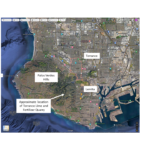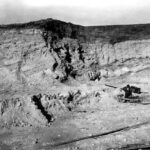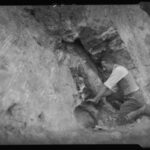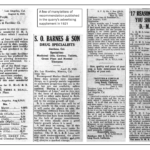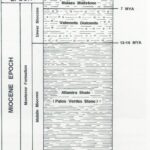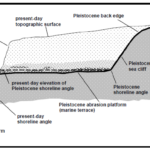
Introduction
It is sometimes difficult to admit that you are (officially) a nerd, but I have a confession to make. I have collected dinosaurs on stamps for the last thirty years. Over 10,000 of these stamps have been issued across the world, and the vast majority of these issues are in my collection. One question that I am often asked is when the first dinosaur stamp was issued, which turns out to be the Chinese 1958 “Chinese Fossils” set of three stamps, one of which features Lufengaosaurus. This dinosaur was originally discovered in 1930 in Upper Triassic sediments of the Yunnan Province in southwest China. The delightful first day cover shows a shy prosauropod resting on its tail (Figure 1.1).
Things become more complicated when you broaden the definition to include any postal items like cinderellas (i.e. virtually anything resembling a postage stamp, but not issued for postal purposes by a government postal administration) and more. The Sinclair oil company’s official brand mascot is Dino, a large green sauropod. This image has featured on many giveaways including stamps that could be stuck in albums. The first set of Sinclair dinosaur stamps was published back in 1935 (Figure 1.2), with four million albums distributed to the public testifying to successful petroleum marketing. Another early dinosaur stamp, painted by John Heber Stansfield, was issued by the Utah Tourist Board around 1932. It showed a large dinosaur skeleton and publicized the state’s Dinosaur Monument (Figure 1.3).
- Fig. 1.1. The first ever dinosaur stamp, from 1958
- Fig. 1.12 Sinclair giveaway dinosaur stamps from the 1930s
- Fig. 1.3. Cinderella dinosaur stamp advertising Utahtamp
(Perhaps) The Oldest Philatelic Dinosaur
These cinderellas are nearing their centenary but I have one postally used envelope in my collection that outdoes them all. Knowing of my interest in dinosaur philately, years ago an American stamp dealer gave me a unique prepaid cover (Figure 2.1), originally sent to the Department of Agriculture by the Torrance Lime and Fertilizer Company, of Lomita, California in 1922. The envelope has an embossed stamp, in addition to a printed sketch showing a wide variety of ancient animals, including a somewhat dubious dinosaur sketch (Figure 2.2). The cover raised so many questions for me. What was this company? Why were there ancient animals (and a caveman) pictured on the cover? What was originally in the envelope? Was the company still in business? The more I researched these questions, the more data I uncovered, spanning social history, geology and palaeontology.
Examining the envelope (Figure 2.1), the most striking detail is the large sketch in green ink. It shows a saber tooth tiger (Smilodon californicus) roaring as it stands over a Columbian mammoth carcass (Mammuthus columbi) in a tar pit. Several dire wolves (Canis dirus) are squaring up the big cat, while a solid looking caveman stands to the right. A small, wobbly sauropod dinosaur (Figure 2.2) stands in the shade of the palm trees in the background. Also of note is the marine shell on the company logo (upper left) and further shells in the foreground. The basis for the main sketch was an original drawing (Figure 2.3) by Robert Bruce Horsfall for the book “A History of Land Mammals in the Western Hemisphere“, written by Robert Berryman Scott [1], dating back to 1913. The Neanderthal figure is from a 1920 Chicago Field Museum diorama. The dinosaur on the cover appears to have been added at the last minute by someone who was NOT an artist!
The envelope itself is a piece of “postal stationery” i.e. it has a stamp printed directly onto the envelope to pay the postage. The envelopes were sent to the Post Office where the stamps were struck on paper, referred to as “stamped to order” or STO. Paper had to be submitted flat and unfolded and stamping was done with the same embossing presses as used for Post Office envelopes. In 1922, the date of the postmark on the envelope, the domestic postage letter rate was 2 cents/oz. The embossed image, carmine in colour, shows George Washington.
The envelope is postmarked March 31, 1922, which was a Friday. On that day, KFI-AM in Los Angeles, CA began radio transmissions and Prince Hendrik opened a trade fair building in Amsterdam. The actor Patrick McGee (A Clockwork Orange; Barry Lyndon) was born in Armagh, Northern Ireland. Temperatures in Los Angeles reached 61° F, with a low of 50° F and no precipitation [2]. Across the world that year, Russia was enduring a terrible famine, Mussolini’s Fascist Party seized control of the Italian government, Stalin was appointed General Secretary of the Communist Party, Egypt gained independence from Britain, the first successful insulin treatment of diabetes was made, and the silent film Nosferatu premiered in Berlin. The US President made his first speech on the radio, the BBC was created, and the Hollywood and Rose Bowls opened.
- Fig. 2.1 Cover advertising the Torrance Lime and Fertilizer Company in California
- Fig. 2.2. The envelope is dated March 31, 1922 and features the FIRST EVER dinosaur on a postal item
- Fig. 2.3. The image is taken from a painting by Robert Bruce Horsfall
Torrance, California
Torrance was founded on May 31, 1911, by Jared Sidney Torrance through the purchase of 2791 acres of land from the Dominguez Estate Company for $976,850. Other names were considered (including Southport, Coronel and Industrial) but the board approved the resolution calling for Torrance, over the objections of Jared. The city was incorporated on May 21, 1921 [8]. It is a coastal city in the Los Angeles metropolitan area in California (Figure 3.1).
By far the most fertile source of information about everything Torrance, including the Fertilizer Company, can be found in the newspaper archives of the time [9]. The Torrance Herald was the city’s newspaper of record from 1914 to 1969. The Herald started as an advertising sheet singing the praises of the new “modern industrial city” and evolved into the premier newspaper of the rapidly developing city. The Torrance Enterprise also began as an advertising sheet that grew into a newssheet.
Throughout the 1920s, both papers chart the rapid growth of the city, while sharing some wonderfully parochial tales: who was taking tea with whom, who had been bitten by a dog and much more. Newspaper headlines in 1921 included “Lamp posts painted”, “Truck stuck in the mud”, “White Gopher Caught” and, in 1922, “Huge melon on display” and “Free Fish Friday For Red Haired Girls Causes Rush”. Much of the information in this article that relates to the Torrance Lime and Fertilizer Company is drawn from these newspaper archives.
Scouring the pages in early 1921, adverts promoting Torrance as a growing city, sponsored by the Dominguez Corporation, took pride of place in every issue. There were also stories every Friday (the day that both newspapers were published) relating to the Torrance Lime and Fertilizer Company (see section 6). In a newly founded community, somewhat short of real news, it is likely that sponsorship by the company enabled them to place abundant stories about the efficacy of their fertilizer but, as we shall see later, the company went way beyond this.
The fame of the Fertilizer Company was short lived. On February 26th, 1921, the Chanslor-Canfield Midway Oil Company (CMO) spudded a well in Torrance. The Torrance Herald reported a major strike at the Santa Fe Well No. 1 two miles from town on Aug. 18, 1921, and another gusher at the well occurred on Dec. 7, 1921 (Figure 3.2). The find came to be known as the Del Amo Field, with the well initially coming in at a rate of 2,500 barrels a day. Soon, a belt of wooden oil derricks carpeted the southern half of the city, stretching from the Southwood area to present-day Harbor City and Wilmington. The oil rush gradually “out-newsed” the stories of fertilizer mining.
- Fig. 3.1. Map showing the location of Torrance to the north of Los Angeles
- Fig. 3.2. Oil discovered in Torrance
The Torrance Lime and Fertilizer Company
Two Lomita boys, hunting for pirate gold, came upon a deposit of limestone (Figure 4.1) which, after months of investigation, gave promise of being one of the most lucrative strikes in Southern California. The find was made on the Weston Ranch, which adjoined the Palos Verdes hills (Figure 4.2), the property of Frank Vanderlip, the founder of Citibank and co-creator of the Federal Reserve [4].
The Torrance Lime and Fertilizer Company was formed in 1919 to exploit this deposit. Pulverizers and crushers were ordered, as well as two revolving kilns. A road was cut through the hills so that the product could be brought into Torrance by trucks. The directors of the company were George Towne, President, W. Johnston, vice-president, with Frank Sammons as secretary and treasurer. A decision was made in November 1921 to develop the company as rapidly as possible. They also decided to change the name from the TL&FC to the Decomposed Marine Shell and Bone Company, DMS&B, with these initials as trademark.
The company later opened a second quarry in Lomita, as described in an old Californian mining journal:
Lomita (southwest of), Los Angeles County, California – Palos Verdes Limestone Deposit (Algal Limestone)…… limestone was produced for 3 years 1927-29 inclusive, by Torrance Lime and Fertilizer Company. It was used primarily by Pioneer Compost Company and also by citrus fruit growers on adobe soils…..These fossil beds are reported to be 30 feet thick and are covered by 12 feet of adobe soils. They are probably Quaternary (Pliocene).
The quarry mined fossiliferous Pleistocene marl and limestone, dipping to the northwest. Nodules of phosphorite were present in the marl, making the deposit suitable as a fertilizer. The open pit was 300 feet long, 200 feet wide and 60 feet high (Figure 4.3) and mined with a dragline scraper, with the production crushed in a 100-ton plant on the property. The location of the quarry was listed as being on the East Slope of Palos Verdes Hills (Sec. 34, T. 4 S, R. 14 W), about 1 mile southwest of Lomita [6]. The Lomita Quarry yielded many fossils, mostly invertebrates, but was outshone by the original Torrance Lime and Fertilizer Company. Its numerous fossils were alleged to make it the world’s best fertilizer (see section 6).
- Fig. 4.1. The newspaper story of the discovery of the Lomita Quarry
- Fig. 4.2. The Palos Verdes hills where the quarry was located
- Fig. 4.3. The open pit worked by Torrance Lime and Fertilizer
The Colour Purple
By 1921, the makeup of the board had evolved, with Frank Sammons promoted to President, Richard. C. Kite as secretary and Samuel Maus Purple (Figure 5.1) hired as General Manager in March 1921. Purple was born in 1878 in Pennsylvania. His profession was listed as an archaeologist, but census records [10] indicate that he was always a salesman, so maybe he embellished the truth a little. He even wrote an extended article on sales techniques in the Torrance Enterprise in June 1921. He focused on patient, persistent effort, putting the customer at ease, acquiring an education and energy.
As we will see, he was also an obsessive amateur palaeontologist (Figure 5.1), a penchant that came to the fore in his job at The Torrance Lime and Fertilizer Company. Later in his career he kept up an interest in geology, discovering a large, steaming, volcanic crater (Figure 5.2) near Santa Paula, CA, in 1930 [11,12]. He and his wife had two daughters and eventually retired to Monterey, where he died in 1965 [10]. His wife donated his scientific papers to the National Library of Medicine (U.S.) in 1967 and his fossil collection to the Municipal Museum of Riverside, California in 1968.
S. Maus Purple, brought every ounce of his expertise to bear when it came to getting the most out of the mine. He immediately recognized that the fossil component of the excavated material could be used to advertise the product and invited many scientific experts to visit the mine to share their expertise. Based on their input, Purple wrote and disseminated numerous stories in the press (faithfully reported in the Torrance Herald and Torrance Enterprise newspapers) as well as handing out editions of the “Life Extension Bulletin”, a privately financed newssheet, to visitors to the mine. These included advertisements, testimonials, letters from scientists, geochemical reports and geological stories aplenty. They certainly make for entertaining reading, more than one hundred years later, and at the time the company must have been one of the largest in Torrance, the burgeoning city.
- Fig. 5.1. S. Maus Purple, the quarry manager
- Fig. 5.2. Purple in the field
Advertising – a Purple Patch
The two “Life Extension Bulletins” presented to quarry visitors by Purple, together with adverts sprinkled through local newspapers (Figure 6.1), did not hold back when singing the praises of their fertilizer:
D.M.S. Lime will singly and alone render land more productive than any other substance used as a fertilizer
…unless more lime is put into the soil, strong-limbed athletes cannot be developed in this country…
Our Heavenly Father in His supreme wisdom has placed this vast deposit of ancient marine shell lime at the very gates of the centre of one the greatest agricultural districts of the universe….. Use D.M.S. Lime and stimulate your faith!
“I used about three tons of D.M.S. to less than one half acre of ground, which was very hard adobe. The D.M.S. absolutely turned the adobe into an aerated broken up soil, on which I grew the largest and best crop of melons” (J.E. Chandler)
It makes the crops grow and the ranchers crow
The papers also published many testimonials from satisfied customers (Figure 6.2), along with details on the analysis of the bedrock. Reading through some of this material, mostly drawn from the Torrance Enterprise newspaper, seems like overkill, but other fertilizer companies were up to the same tricks (Figure 6.3). Purple also pushed stories about the fossils (as we shall see below), and some of the finds at the company quarries made their own headlines: “Monster Shark Tooth is Found – Largest Specimen Unearthed in History” (Figure 6.4).
One unusual decision made by the Company was the rebranding of the Torrance Lime and Fertilizer Company to the Decomposed Marine Shell and Bone (DMS & B). It hardly seems a very catchy title but is proudly displayed on every advert (Figure 6.1) and even on the original envelope (Figure 2.1).
- Fig. 6.1. Adverts for D.M.S. Lime
- Fig. 6.2. Testimonials from fertilizer customers
- Fig. 6.3. Rival fertilizer advertising
- Fig. 6.4. Newspaper story about a giant shark fossil found in the Torrance Fertilizer Pit
Purple and the Academics
In May 1921, Purple invited over one hundred distinguished visitors to visit the DMS&B lime deposits of the TL&FC south of Lomita (Figure 7.1). After examining the different formations that had been exposed, luncheon was taken, and several “shots” put off that were real blasts. Many interesting discoveries were made after the blasting including jaw bones, thigh bones and wish bones. Most exciting was the tooth of a sabre tooth cat, fully 5.5 inches in length. There were three shots made, the third one being quite disastrous, throwing a large boulder over onto the office building and puncturing the roof. No-one was hit, however. As mentioned earlier, Purple also distributed a unique and well-edited newspaper entitled “Life Extension Bulletin”.
Purple clearly spent significant amounts of time looking for fossils. He put many on show at the quarry and in the window of Lee’s Grocery Store, advertised under the title “Fertilizing with Fossils” and published a map to help visitors find their way to them (Figure 7.1). Exhibits included “teeth, vertebrae, feet and toes”. Maus sent specimens to several experts in the southwestern US, one of whom was Professor David Starr Jordan. He wrote back, describing the fossils as “a most extraordinary mixture of land and sea stuff”. “The mammal bones seem to be fragments of whales and… sea lions, perhaps”. He was particularly excited by the shark teeth: “The two large shark’s teeth are especially valuable because they are different from any that we have ever received and the species, one of the great white sharks, seems to be new to science. The fish must have been nearly 100 feet long”. He eventually identified at least four species of Carcharodon, the great white shark, and several other shark species. He eventually named one of the new species of Carcharodon after Purple.
David Starr Jordan was a New York native who received both medical and doctorate degrees in Indianapolis, helped to name more than 2,500 species of fish and served as the founding president of Stanford University. His support of eugenics led to the removal of his name from several buildings.
Ernest Locke (geologist) wrote to Purple to say “I am of the opinion, judging from a short visit to your property, that your deposit was formed near the mouth of a river emptying into the ocean, in the shallow brackish waters of which lived and died the organisms whose shells in incredible numbers accumulated for centuries and centuries…..the deposit apparently belongs to the Tertiary period, judging from the fauna remains and especially from the immense shark’s teeth discovered there”.
Other visitors included Dr. Milbank Johnson, president of the Southwest Museum and a staff of scientists. Purple had agreed for the museum to take over all the fossil remains, while the museum would be ready to rush trained excavators to the scene whenever particularly promising remains are brought to light. Professor Chester Stark, an eminent geologist, and Dr Wyman of the Museum of History, Science and Art, also visited, the latter marvelling at a 4.5 inch long shark tooth: “far and away the largest shark’s tooth recorded”.
Fig. 7.1. Invitations to Palaeontologists to visit the Pit
Geology
The geology of the area was described by Professor Ellis Bailey, Professor of Geology at the University of Southern California in 1922 (Table 1). Those containing significant fossils in the Torrance Lime and Fertilizer Pit are highlighted in yellow. The company’s lime deposit is on the edge of the fault line, which occurs at the base of the hills from Redondo to San Pedro and is about 250 feet above sea level. The origin of this vast deposit of decomposed marine shell is due to an accumulation of shell fragments and foraminiferal cases on the ocean bottom.
Table 1. Stratigraphy and palaeontology at the DMS&B marl pits according to Professor Ellis Bailey. My comments from other references in italics.
Bailey’s interpretation, published in the company’s Life Extension Bulletin in 1922, fits closely with modern ideas (Fig 8.1; 8.2). An island (“Palos Verdes Island”) was formed by uplift, perhaps 1 million years ago [16, 17]. The island was cored by the Altamira Shale. Continuing changes in relative sea level created at least 13 terraces at different elevations (Figures 8.3; 8.4), on which mainly shallow marine deposits were laid down [17,18]. The stratigraphy is often complex due to repeated downcutting and deposition as well as relative sea level changes (Figure 8.3). The Palos Verdes sand was deposited around the island and some distance beyond. Sedimentation was influenced by the ongoing subduction of the Pacific Plate, leading to significant tectonic deformation, and localized angular unconformities are common.
- Fig. 8.1. Stratigraphy of the D.M.S. Pit
- Fig. 8.2. Regional geology map
- Fig. 8.3. Diagram showing cross-section through terraces
- Fig. 8.4. View of marine terraces
Palaeontology
Most of the Pleistocene-age land animals found in the La Brea Tar Pits have also been found as fossils in the Palos Verdes Hills [18]. Terrestrial animals swam across the island and their remains were sometimes incorporated into the terrace deposits. Fossil invertebrates were so common that thousands of complete shells have been collected. Scientific collections of fossils from the area date back to 1903, when Arnold published a book on the paleontology and stratigraphy of the Plio-Pleistocene of San Pedro [22]. Today only a few Plio-Pleistocene sites remain, but there are many Miocene deposits of the Altimira Shale still accessible by fossil hunters [18]. Only a few of the many quarries formerly worked in the region remain undeveloped.
Several technical papers have been published on the fossils yielded by the quarry [18,19,20,21], but the newspapers of the time provided much more graphic descriptions (Figure 9.1):
“World’s Greatest Fossil Bed at Palos Verdes” (San Pedro News Pilot 1923)
They went back 1,000,000 years yesterday in digging down ten feet on the property of the Torrance Lime and Fertilizer Company at their quarries on the O.S. Weston Ranch South of Lomita…. Scientists spent the morning examining and appraising the various bone, shell and rock specimens as they came up in…excavations which promise to be among the most important in Southern California (1921).
Although solely for commercial purposes…the excavations have produced fossils from 5 to 1 million years before this era and have also yielded a portion of an immense pelvic bone…… In those ten feet of lime deposits is packed the recurring drama of 1,000,000 years…. Great sharks battled….large trees…the Imperial elephant…the sabre toothed tiger pounced upon him, sinking his 12 inch teeth into the helpless victim…. And almost yesterday, it seems, a famished and desperate man…tunnelled several yards, using a clumsy, heavy shale, scraper to the source of a stream….. They found traces of him today, a few bones mixed with those of the shark, the teeth of a wolf (April 1921).
Workmen in charge of the TL&FC…have dug up a human foot, perfect in shape, and alongside of this grewsome find was a battle-ax… the foot rests on its outer side and it is exceptionally long …. In addition to the “near-foot” and the human weapon there are bones… that ape-like man was in tropical surroundings and luxuriant foliage…He had to do with the imperial mammoth, standing fully 15 feet high and possessing spear-like tusks. The fossil remains of such a creature…are plentiful in the pit. The giant sloth… the primitive three-toed horse, the bear, the wolf, the tree-browsing camel and a strange kind of deer, and a rhinoceros-like ungulate with ferocious straightforward horns. But most terrifying of all, perhaps, was the saber-toothed tiger…having teeth some fifteen inches long…(1921).
Starr mentioned that a few of the shells were from deep water, the rest from the shoreline (Figure 9.2) [20]. There were bones of whales and (probable) sea lions. There were four species of Carcharodon (Figure 4.3), the Great White Shark and several other shark and ray species (more than 100 teeth in all). There were also sea lion teeth, tusks and bird bones. Land mammals included paws of a bear, vertebrae of a giant sloth, bones of a great wolf and of a lion, the nasal bone and teeth of an imperial elephant (which “weighed 6 ¾ pounds and measures 8 ½ inches across the chewing surface”: Figure 9.4), the tusk of the saber tooth tiger and a hippopotamus and bones of the five toed horse. One important discovery was the tooth of a prehistoric crocodile (An “animated leather lizard…the first found west of the Nile”). Other authors have reported the tusks of mastodons (Figure 9.4) and the remains of several fossil whales over the years, including a 2 million year old whale from the Palos Verdes Hills, near Lomita, found in 1921 [18].
- Fig. 9.1. Newspaper articles about fossils found at the company Pit
- Fig. 9.2. Fossil molluscs from the Lomita Pit
- Fig. 9.3. Fossil shark teeth, some found by Purple and described by Starr Jordan
- Fig. 9.4. Fossil mammal remains from the D.M.S. pits
Summary
Without a doubt the gift of a simple envelope sent me down a fascinating geological rabbit hole. It also served to demonstrate the amazing resources that are out there for the intrepid researcher. Genealogical records, the census, newspaper archives and technical published papers can be used to paint an incredibly detailed picture of life in the 1920s (I have skipped a lot of the mundane stories from the Torrance Herald and Enterprise newspapers but feel free to explore the 1920s newspapers further [9]). Added to this was a really interesting geological story that provides direct analogues to Cretaceous sedimentary deposits of the Western Interior Seaway, along with the chance to explore a “La Brea” fossil fauna preserved in a completely different depositional setting. Finally, I salute the maverick S. Maus Purple, who showed that even the most amateur of geologists can have their day in the limelight, and end up having a species of Great White Shark named after them.







